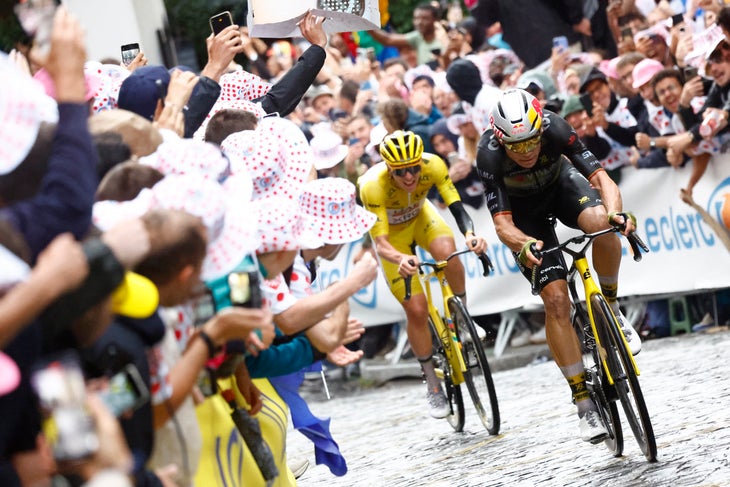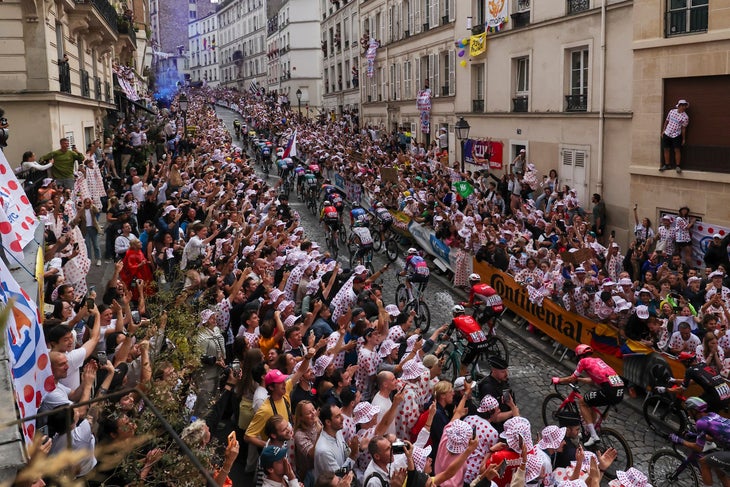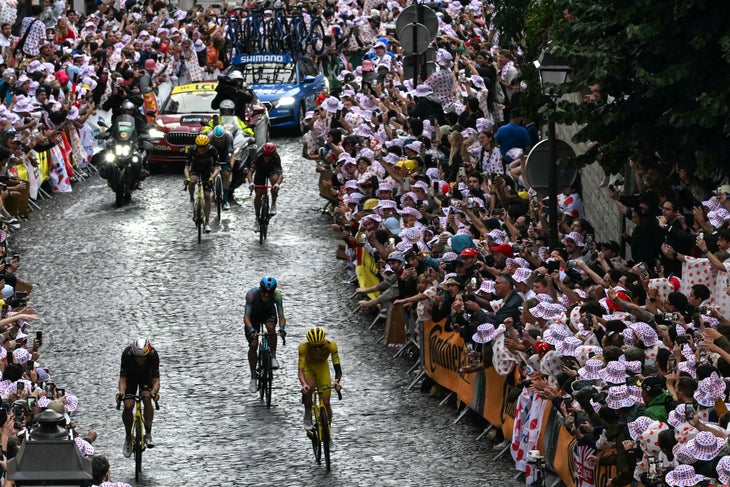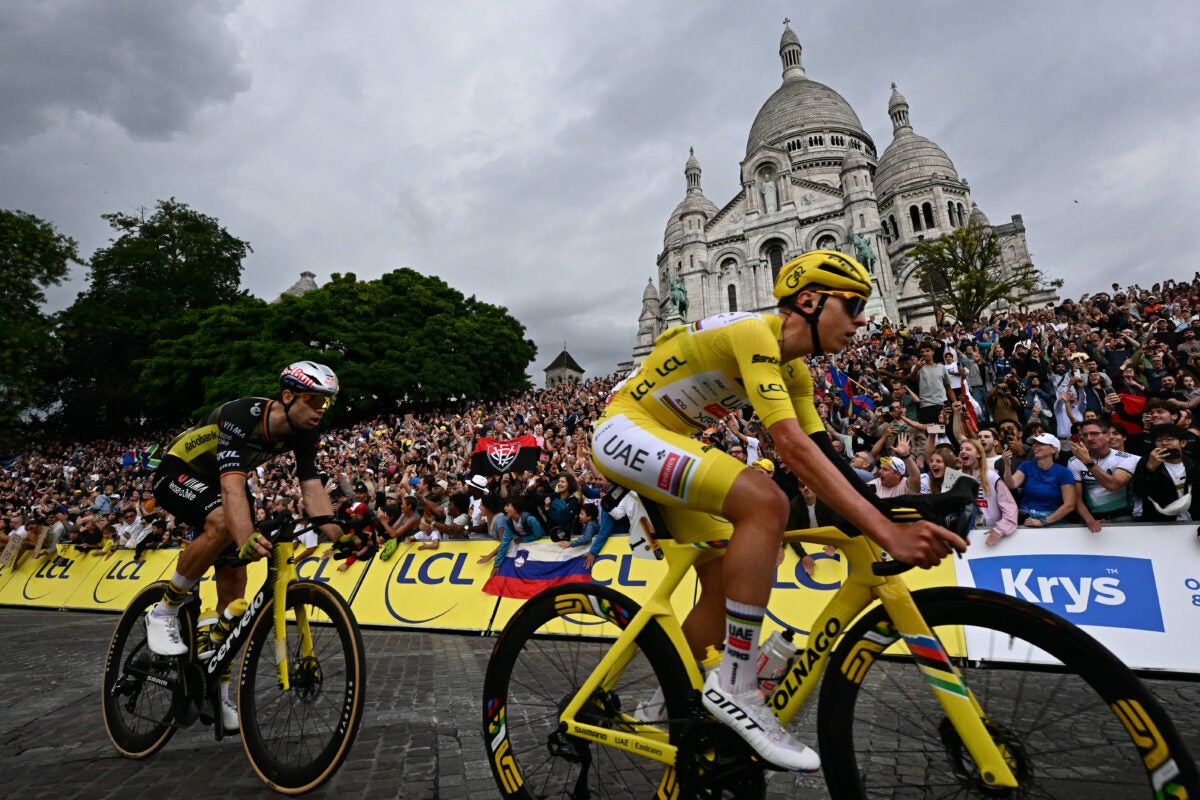“], “filter”: { “nextExceptions”: “img, blockquote, div”, “nextContainsExceptions”: “img, blockquote, a.btn, a.o-button”} }”>
Sunday’s new-look final stage of the Tour de France has been feted for the dramatic outcome and also the huge crowd sizes.
The spectators loved it, many of the riders loved it — sprinters aside — and the TV viewers drank it up.
It seems Tour organizers ASO loved the laps of Montmartre too.
First billed as a one-off, the iconic Parisian hill could be appearing again and again.
“Of course we want to continue to pass through Montmartre,” Tour de France Deputy Director Pierre-Yves Thouault told Le Parisien.
“The success has surpassed our hopes and, inevitably, the desire to place this new parcours into the long-term plans is there.”
The twisting paved climb made its pro cycling debut in the 2024 Olympic Games, with Remco Evenepoel (Belgium) and Kristen Faulkner (USA) winning the men’s and women’s road races.
Despite the success and spectacle of that course, ASO initially dismissed suggestions that Montmartre could feature on the final stage of the Tour.
However it had a change of heart and introduced it this year.
The drama of Sunday’s final stage plus the jubilation of the fans has stunned ASO and others, meaning the once in a lifetime conclusion to the Tour could end up being a lot more regular than that.
The sprint specialists will be disappointed if that’s the case, given that the traditional laps of the Champs Élysées were regarded as the unofficial sprinters’ world championships, but, for now at least, ASO seems determined to head in this new direction.
Work needs to be done first, however.
‘Everything went well…everyone liked it’
 Wout van Aert makes his winning move on the final ascent of the climb. (Photo: Etienne GARNIER / POOL / AFP)
Wout van Aert makes his winning move on the final ascent of the climb. (Photo: Etienne GARNIER / POOL / AFP)
According to Le Parisien, bringing the Tour to Montmartre this year was a complicated process.
The Paris City Council and the President of the Republic quickly backed the plan, but it took time to obtain the necessary administrative authorizations.
Because of that, ASO said it needs to do consultations
“Very quickly, we will debrief, around a table, with the representatives of the city and the prefecture,” Thouault said. “We will see the possible points of improvement. I am thinking in particular of the accessibility of the public in certain places. But on the whole thing, everything went very well. Everyone liked it. Both the public and the riders.”
Indeed videos and photos from the climbs showed riders soaking up the atmosphere. One image of Primož Roglič captured the mass of spectators and also what the experience meant to him.
The climb is very narrow, something which caused some concerns beforehand. However something which helped greatly was the decision to neutralize the GC times due to rain on the circuit.
This enabled riders who weren’t intending or indeed able to chase the stage win, plus those concerned about danger, to sit up and spread out.
Jonas Vingegaard referenced that when he gave his thoughts on the new circuit.
“I didn’t really enjoy it that much,” he said in the post-race press conference. “I enjoyed listening to the radio, though, while suffering on the cobbles myself. I really enjoyed listening to how the team were doing, how Wout [van Aert] and Matteo [Jorgenson] were doing. That was nice for me.”
Thumbs up from Van Aert, but with a note of caution
 The atmosphere on Montmartre was monumental. (Photo: Catherine Steenkeste/Getty Images)
The atmosphere on Montmartre was monumental. (Photo: Catherine Steenkeste/Getty Images)
His Visma-Lease a Bike teammate Van Aert had a different view.
That’s due in part to his performance: he pulled off one of the most impressive rides of his career, dropping Tadej Pogačar and soloing in alone.
“Of course I did enjoy the final because it was quite selective,” he said. “It was pretty quickly a small group in the front. It was how it should be.
“The guys who still want to race can take the risks and be up there and go for it.”
There’s a similar diversity of opinions amongst other riders.
Both Vingegaard and Van Aert said it was important that the GC times were neutralized. Otherwise, the latter pointed out, it could have been very dangerous.
That’s something ASO will have to consider.
“It is [otherwise] just impossible to create a safe race on this circuit, in my opinion,” Van Aert said.
“If you are let’s say in 100th position you are already two minutes behind because it is so technical. So I think we should not look for that. But how it was today, you still had an exciting race to watch.
“And for riders who went for the victory, that was nice.”
The debate will go back and forth, and even more if and when ASO finalizes plans for next year.
Influential figures on board
 The inclusion of the climb of Montmartre was a spectacular success. (Photo: Hugo MATHY / AFP)
The inclusion of the climb of Montmartre was a spectacular success. (Photo: Hugo MATHY / AFP)
So what happens next?
According to Le Parisien, the initial step is the planned debrief with representatives of the city and the prefecture.
Then ASO will officially submit a dossier, similar to that used to secure authorization this year.
But there is one key difference to what will be sought next time: a multi-year approval.
The newspaper cites the one-off plan to race around the Arc-de-Triomphe in 2013, which then became a perennial authorization.
ASO will look for the same: apologies in advance to the sprint specialists.
Le Parisien expects that the green light will likely be given to ASO in September, and that the return to the climb would be confirmed at the Tour de France route launch later this fall on October 23.
As for whether the political will is there to do it, the paper cites the endorsement of Pierre Rabadan, Paris’ Deputy of Sport. And, not insignificantly, the news that French president Emmanuel Macron was ‘enchanted’ by the spectacle of the final stage.

